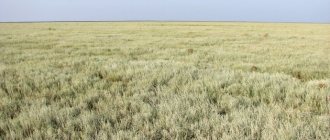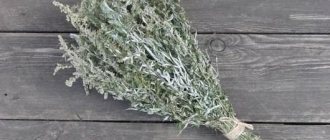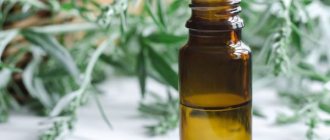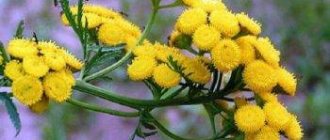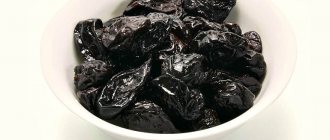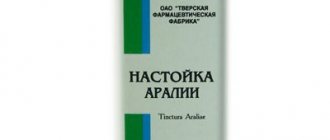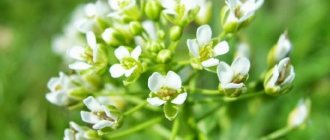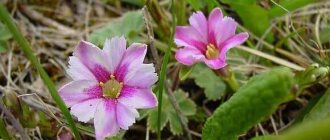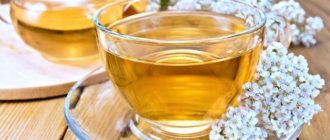History of the name
Today, science knows about 400 species of this plant, the most common of which is Artemisia absinthium or wormwood. Inquisitive people are interested not only in the duality of the effects of drugs made from it on humans, but also in the name, about the origin of which researchers have no consensus.
Most scientists believe that the Latin name artemes has Greek roots and translated into Russian means “healthy.” And indeed, since ancient times, it has been considered by all peoples as a kind of panacea, a remedy for all diseases, and a giver of health. the famous scientist historian Pliny wrote that the winners of running competitions, which were usually held on sacred holidays, were awarded wormwood juice so that they could maintain their health at a high level.
Another assumption is based on the fact that one day the wife of King Mausolus, whose name was Artemisia, became very ill. All attempts made by doctors to cure her were unsuccessful, and only drugs made from this plant were able to bring relief to the patient.
The third version of the origin of the name goes back to the goddess Artemis, the patroness of women in childbirth. According to ancient Greek myths, she used wormwood and products that included its elements as a birth aid. By the way, the priestesses of Isis, the ancient Egyptian goddess of motherhood and fertility, also used this plant and even wore wreaths woven from it on their heads.
The second part of the species name absinthium is also borrowed from Greek and is translated as “without pleasure.” In fact, despite the many beneficial qualities of the plant, medicines containing wormwood are incredibly bitter. Even the Russian name is associated with the bitter taste of the plant. The Slavic “leti”, which gradually transformed into “wormwood”, means “to burn”, because even a small leaf can cause a strong burning sensation in the mouth.
This is one of the most bitter plants that occurs naturally in our country. It is about this that we can say that one teaspoon of crushed parts of the plant can make a whole barrel of honey bitter. Even with a dilution of 1:10,000, the bitterness will be quite sensitive.
But it’s not just bitterness that distinguishes this plant. Have you ever smelled the steppe, among the herbs of which there is wormwood? It is simply impossible to forget this bitter smell! Everyone knows what strong associative connections connect the sense of smell with emotions. Russian cosmonauts take a sprig of wormwood with them on flight. This plant retains its aroma longer than others, which reminds them of the Motherland and its wide open spaces.
Only tarragon, one of the varieties of wormwood, does not have such special distinctive properties. Its specific taste and smell do not contain bitter shades at all. This plant has been known for as long as wormwood. The inhabitants of Ancient Syria called it tarragon. It still grows in many countries of the world, including Russia. The famous carbonated drink Tarragon, which is popular in our country, is made precisely on its basis.
Contraindications
Despite the fact that wormwood is a very effective and beneficial plant for the human body, it can still cause harm if used incorrectly. Wormwood can be used only if there are no contraindications - otherwise it will harm your health. To protect yourself, it is important to know for whom wormwood is contraindicated. Let's consider.
- Wormwood should not be used even in small doses during pregnancy and while breastfeeding.
- Should not be used for gastritis, peptic ulcer with high acidity. In general, increased acidity is a contraindication to the use of wormwood.
- You should not use wormwood if you have epilepsy - it can provoke the development of an attack.
- The use of the herb is prohibited for children under 7 years of age, and for those older only with the permission of a pediatrician.
Description of the plant
As mentioned above, there are over 400 species of wormwood in the world, about 80 of which are found in different regions of our country. Most often this is wormwood and common (field) wormwood, also known as wormwood, Chernobyl, tarragon, serpentine. It is used in private farms and grown as a garden plant. Parts of it are used to make tarragon vinegar and added to marinades.
Japanese and Chinese species (wormwood moxa, Chinese) are the basis for the production of wormwood cigars and cones for moxa therapy - an unconventional method of treating various diseases, including chronic diseases of the gastrointestinal tract, reproductive system, cancer, tuberculosis, rheumatic pain, and so on.
In Asian countries, in the south of Russia, the following types of wormwood grow:
- Russian tsitvar or Tatar wormwood;
- Adeppian tsitvar (Persia, Asia Minor);
- barbarian tsitvar (African) and so on.
Their seeds are a powerful anthelmintic, widely used in folk medicine, as a home remedy and known as citvar seed. Its effect is explained by the high content of santonin in the seeds and baskets (inflorescences).
Some of the most decorative species, such as Artemisia chamomile, are used in gardening and landscape design. This is a densely branched, rarely flowering southern European species.
Wormwood is a perennial plant belonging to the Asteraceae family. Different species have their own distinctive characteristics, but they also have common features. Let's look at the appearance using wormwood as an example. The erect, silvery-grayish, slightly ribbed stem, covered with small short hairs, can reach a height of 1.5-2 m. The leaves of wormwood are long- and short-petioled, twice and thrice pinnately dissected.
The flowering period lasts from June to August. Small yellow tubular flowers are collected in spherical drooping baskets, forming a pyramidal panicle in the upper part of the stem. In August-September, in place of flowers, fruits are formed - oblong, wedge-shaped, brownish achenes. Wormwood has a lot of seeds, which allows it to quickly spread, occupying more and more new spaces.
In our country, wormwood is found in the wild in the southern regions, the European part, and the Far East. Most often it can be found in deserted, abandoned areas, along railway embankments, at the edge of the forest, along the sides of roads, near housing.
Wormwood in folk medicine
The medieval poet, doctor, scientist and Odo of Mena, who lived in the 10th-11th centuries, wrote the poem “On the Properties of Herbs”, in which he collected information about plants and their use in medicine obtained by Galen, Pliny the Elder Dioscorides and other ancient and medieval physicians. He described more than 100 plants, including wormwood, called the “mother of herbs.” According to his statements, once you have tried this plant, you will not be afraid of either wild animals or poisonous potions.
Preparations from wormwood were recommended as a strong antidote, allowing one to heal from poisoning by fly agaric and hemlock, and were offered as a remedy for treating wounds received by soldiers in battles. With their help it was even possible to “defeat the sea dragon.”
In folk medicine of different countries and peoples, wormwood was widely used (and is currently used) as a medicinal plant for the treatment and prevention of a wide variety of diseases:
- for internal diseases such as colds, fever, rheumatism;
- as a choleretic, anthelmintic, diuretic;
- as a sedative and pain reliever, including during childbirth;
- in gynecology, for the treatment of amenorrhea, dysmenorrhea and other female diseases;
- for the treatment of nervous disorders, neurasthenia, as an anticonvulsant during epileptic seizures;
- to get rid of alcohol addiction (in combination with thyme in a ratio of 1:4);
- for stomach diseases (low acidity), as a means of increasing secretory activity;
- to strengthen hair;
- for rinsing the mouth during attacks of toothache;
- for obesity and to solve many other problems.
The root of wormwood has a calming effect, and the leaves have an analgesic effect. Extracts, infusions are prepared from various parts of the plant, compresses, poultices and lotions are made. Crushed stems and leaves are mixed with fats and used to treat abscesses, wounds, and to lubricate frostbitten areas of the body.
Syrup made from herbs is highly effective for liver diseases, including hepatitis, various colics, diseases of the spleen, and for removing stones from the urinary tract. To prepare it, the raw materials, about 100 grams, are soaked in clean, preferably boiled or filtered water. After a day, the resulting infusion is brought to a boil. Cool, add sugar (400 g) and cook until thickened. It is taken 3 times a day, a tablespoon.
A decoction of the roots is used as an antitumor agent for lesions of the rectum, stomach, and uterus. In Switzerland, for inflammation and swelling of the tonsils, they prepare and drink wormwood tea. There have been no specific scientific studies of its effects, so it is suggested to start with small doses. The tea should be weak and not rich. In this case, it is also possible to use wormwood essential oil. By the way, Queen Cleopatra used it to prepare eau de toilette.
In China and other Eastern countries, a traditional treatment method known as ju therapy (moxo therapy) is widely used in these countries. It involves a thermal effect on biologically active (reflexogenic) areas of a person using special wormwood cigars. This effect allows not only to cure an existing disease, but can also be used as a prophylactic agent to eliminate dysfunctions of the organs for which this point is “responsible”.
Wormwood is an excellent sanitary and hygienic product, widely used as a disinfectant during epidemics, even for such terrible diseases as plague and cholera. It was used to fumigate homes, villages, sick people, and infected animals.
Dried parts of the plant retain an unusual, subtle, bitter aroma for a long time, which has a beneficial effect on the nervous system. When preparing sachets intended to normalize sleep and treat neuroses, a part of wormwood is added to the aromatic mixture of peppermint, thyme (part) and hop cones (2 parts). The pillows are placed at the head of the bed. Dried stems and leaves are used to arrange laundry or place sachets inside wardrobes as protection against moths.
Wormwood for oncology
Wormwood against cancer is not only effective, but also safe for healthy cells, because, unlike chemotherapy, it kills only one normal cell in twelve thousand malignant ones. This explains the fact that during the treatment of cancer with wormwood, the patient does not have such side effects as nausea, vomiting, dizziness, weight loss that occur as a result of intoxication of the body. If the cancer has not yet reached a high stage, then doctors can prescribe therapy with this herb in combination with surgery. In the third or fourth stage, cancer treatment with this herb is carried out with radiation therapy.
Lungs' cancer
Cancer of the respiratory system mostly occurs in smokers with many years of experience. Lung cancer therapy is more effective if it is carried out at the initial stage of tumor formation. Since the disease is a direct threat to the patient’s life, it cannot be treated with wormwood alone. Various products from this plant can only be auxiliary. To relieve symptoms and improve general condition, a tincture of wormwood is made in cognac with the addition of chaga, pine cones, yarrow, rose hips, honey and aloe.
Breast cancer
Breast cancer is the most common type of female cancer. Women most often suffer from the pathology after the onset of menopause, as well as those with benign neoplasms, ovarian dysfunction and genetic predisposition. The main method of treating breast cancer is surgery combined with chemical, hormonal and radiation therapy. You can enhance the effectiveness of therapeutic measures with the help of a classic infusion of wormwood. It is very simple to prepare, you just need to add a tablespoon of wormwood powder to a glass of water and leave for three hours in a dark place. The infusion is taken three times a day, two tablespoons.
Bowel cancer
The tumor can be localized in any part and affect the colon, cecum, colon or sigmoid colon. This type of cancer has a very unfavorable prognosis, as it is characterized by aggressiveness, rapid development and late onset of symptoms. Colon cancer is caused by poor diet, inflammation and heredity. After consulting a doctor, you can drink a water infusion of wormwood.
We recommend reading: How to drink boron uterus for fibroids - methods of alternative treatment
Prostate cancer
This location of cancer is widespread among older men. As an adjunct to primary therapy, this plant relieves symptoms, especially sexual dysfunction. A decoction is used against prostate cancer in courses of ten days. Take two tablespoons of the medicine three times a day.
Uterine cancer
The most common cancer of the female reproductive system is endometrial cancer of the uterus. More often, pathology develops in women before menopause. As an additional therapy, drink thirty drops of alcohol tincture diluted in a glass of water. Treatment must be agreed with the doctor.
Leukemia
Blood cancer promotes uncontrolled division of leukocytes and their accumulation. Pathology begins in the bone marrow, gradually destroying the hematopoietic system. After examination and permission from the doctor, wormwood is drunk as simple tea with the addition of honey. Treatment lasts no longer than two weeks. With three-day breaks every three days.
Cancer of the larynx and tongue
This localization of cancer is often caused by smoking, alcohol abuse, and working in hazardous industries. For treatment, as an auxiliary therapy, you can use a decoction of wormwood, chamomile, calamus and cinquefoil for internal use and lotions. You should drink one liter of this decoction per day and make compresses with 0.5 liters.
Skin cancer
Due to its superficial localization, skin cancer can be diagnosed at an early stage. This gives a good prognosis for complete recovery. You can speed up recovery with the help of wormwood compresses and internal decoction. To prepare it, take thirty grams of the plant per glass of water.
Stomach cancer
Heredity, polyposis, ulcers, and atrophic gastritis lead to gastric cancer. You can use wormwood in combination with the main therapy, this will help relieve symptoms and recover after treatment with chemicals. With this type of cancer, fifteen drops of alcohol tincture are diluted in water and drunk once a day for a week, followed by a week break. The number of courses is determined by the doctor.
Wormwood and magic
Our ancestors classified all objects, including plants, with unusual properties as magical, magical. So wormwood, which has a strong tart odor and medicinal properties that allow one to get rid of various diseases, was endowed with supernatural powers. And not only in ancient Rus', but also in other countries. The bulk of superstitions emphasized the benefits of wormwood for visual acuity:
- on the day of the summer solstice, a big holiday was held, bonfires were lit, if you look at the flames through the “bouquet” of wormwood, you will see perfectly throughout the year;
- in Europe (Bohemia, Germany) hats were made from wormwood, through which they looked at the fires lit on Midsummer Day, which also ensured good vision throughout the year, until the next Midsummer Day.
German farmers cut down wormwood and stacked it in small stacks around meadows and pastures where cows grazed. It was believed that in this way the milk of animals and the entire herd could be protected from witches.
In Japan, to this day, if after a house robbery it is possible to find traces left by thieves, then burning wormwood stalks are placed on them. As a result, the robbers literally have “the ground burning under their feet” and they will not be able to hide from the police and avoid punishment.
Beneficial features
Wormwood has a rich chemical composition, therefore it is widely used for the treatment not only of cancer instead of chemotherapy, but also in conjunction with it. In folk and official medicine it is recommended for:
- atherosclerosis;
- sleep problems;
- anemia;
- diseases of the lungs and bronchi;
- gastrointestinal pathologies;
- inflammation of the urinary tract;
- viral diseases;
- liver diseases;
- neuroses;
- stress.
People who have used the plant to treat oncology and as therapy for other diseases note an increase in the immune system, a decrease in tumor size and an improvement in their general condition.
Do not forget that wormwood is a poisonous plant and in large quantities it can lead to poisoning, therefore the use of folk recipes from this plant is possible only after consulting a doctor.
Before starting therapy, you need to know the contraindications and medicinal properties of wormwood annua. Treatment with wormwood helps stimulate the functionality of the gallbladder and pancreas, removes bile, and improves the absorption of nutrients in the gastrointestinal tract. In addition, the plant is used to treat cardiac diseases, benign and cancerous tumors. Wormwood juice, which is the basis of tinctures, decoctions, and oils, has anti-inflammatory, antimicrobial and antibacterial effects.
Wormwood leaves, stems and flowers contain:
- provitamin A;
- capillin;
- ascorbic acid;
- alkaloids;
- malic acid;
- succinic acid;
- absinthine;
- pinenes;
- flavonoids;
- bisabolone;
- carotene;
- tannins.
These beneficial substances cope with many diseases, but the main active ingredient of wormwood is artemisinin. It is this that has good properties against cancer. People need to know exactly how this component works when taking Artemisia annua against cancer.
For the growth and development of malignant cells, iron is needed in large quantities. Tumors gradually accumulate iron compounds, preventing it from being absorbed in the body, which explains severe anemia in patients at stage 4 of cancer pathology. Artemisinin reacts with such compounds, destroying peroxides and releasing atomic oxygen. In the process, iron oxidation occurs and cancer cells die.
We recommend reading Treatment of cancer with hemlock, its medicinal properties and contraindications
In pharmacies you can buy ready-made medicine from wormwood, but among the abundance of wormwood-based tablets, it is recommended to choose those whose active ingredients are artemisinin and its analogues. Doctors refer to this treatment not as chemical therapy, but as targeted therapy. Because chemotherapy drugs have a detrimental effect on all cells indiscriminately, while targeted drugs act specifically on cancer cells. Wormwood has proven itself in the fight against cancer, so it is prescribed by many doctors both for therapy in the hospital and for home treatment.
Wormwood in official medicine
Modern science carefully studies the methods and methods of traditional medicine, examines the properties of plants used by healers and healers, and if they really have beneficial properties, then they are used to make medicines, products intended for:
- improving the functioning of the gastrointestinal tract;
- increased appetite;
- treatment of chronic diseases of the biliary tract and pancreas;
- normalization of stool.
The procurement of raw materials for pharmaceutical enterprises is carried out twice during the season. Initially, before flowering begins, the basal leaves are collected from the plant during the budding stage. Only leaves are processed, without petioles. After flowering begins, cut off the upper parts of the plant, 20-25 cm long, along with the flowers. If you delay the collection, the flowers take on a brown tint, and the medicinal value of the raw materials is significantly reduced.
The collected parts of the plant are laid out in special drying rooms, under canopies, away from bright sunlight, in a thin layer, no thicker than 3-5 cm, so that the stems do not break. When drying, maintain the temperature within 40-50°C. Store harvested raw materials for no more than 2 years in a dry place, protected from light, in wooden containers or linen bags.
From the harvested parts of wormwood, pharmaceutical plants produce tincture (Tinctura Abstinthii), gastric drops (Guttae Stomachicae), extract, infusion, essential oil, tablets; pharmacies offer dried herbs, both separately and as part of various herbal preparations, for the manufacture of drugs (decoctions, tinctures) at home.
The beneficial properties of wormwood are explained by the presence in the plant:
- organic acids (succinic, malic);
- tannins;
- bitter glycosides;
- alkaloids;
- flavonoids;
- phytoncides;
- ascorbic acid;
- microelements - aluminum, boron, bromine, calcium, potassium, magnesium, molybdenum, nickel, cobalt and others.
Medicines containing wormwood are prescribed to patients with low and high acidity, anemia, and after major operations to increase appetite.
Compound
Annual wormwood has a rich composition. It includes:
- vitamins A, B3, B6, C, K;
- tannins;
- amino acids - leucine and methionine;
- saponins;
- potassium, cobalt, magnesium, boron, bromine, aluminum, nickel, calcium, zinc and other minerals;
- capillin;
- bitter glycosides;
- succinic, acetic, malic and isovaleric organic acids;
- tannins;
- other useful substances.
Along with the leaves, the root of the plant also has beneficial properties. It contains a lot of tannins and bitterness. Due to this, it has a diuretic effect.
It is useful for gout, menopause, dropsy and edema. And in folk medicine they use a decoction based on wormwood annual against cancer of the stomach, uterus and rectum.
Is wormwood a spice?
It would seem that a plant with such an excessively bitter taste cannot be eaten. However, this is not the case in the cooking of various peoples of the world. Wormwood is included in the set of kitchen spices. The most commonly used wormwood in this capacity is wormwood, common wormwood, lemon wormwood, annual wormwood, medicinal wormwood, and paniculata. Dried herbs and fresh herbs are used as a spice. The bright spicy aroma makes it appetizing:
- vegetable and fruit salads;
- soups;
- dishes from meat, poultry, fish, vegetables;
- snacks from cottage cheese and cheese;
- non-alcoholic and alcohol-containing drinks - tea, beer, ale, grape wines, absinthes, aperitifs, liqueurs, vermouth;
- marinades;
- vinegars;
- bakery products;
- canned fish and vegetables.
When adding wormwood to dishes, the main thing is to maintain proportions. If the amount specified in the recipe is even slightly exceeded or the time for adding spices is not observed, the dish may become overly bitter and unsuitable for food.
Wormwood poisoning
The use of plants, which contain many biologically active substances, is always associated with the possibility of causing harm to human health in case of overdose, incorrect or untimely use. This also applies to wormwood. Back in the Middle Ages, people drew attention to the fact that in case of excessive use of medicines that contain drugs obtained from wormwood, a person experiences hallucinations, becomes dizzy, and exhibits other problems.
The following 3 substances lead to poisoning:
- Tauracin – causes disturbances in the functioning of the autonomic system;
- thujone – weakens inhibition processes in the brain, which leads to excessive neuropsychic agitation, the manifestation of convulsive syndrome, and inappropriate behavior of the patient;
- essential oil - easily absorbed from the gastrointestinal tract and has a negative effect on the central nervous system.
Particular care should be taken when using wormwood preparations when treating children.
Signs of intoxication
You can use herbal remedies and medicines that contain wormwood only as prescribed by a doctor, who can determine the need for this method of treatment and calculate the dosage. Improper use leads to intoxication of the body, which can be expressed in the form of the following symptoms:
- nausea, excessive salivation, vomiting;
- paleness of the skin;
- slow heartbeat, weakness, dizziness;
- flatulence, diarrhea;
- fainting, hallucinations, clouding of consciousness;
- swelling, convulsions, increased frequency of epileptic seizures in patients with epilepsy.
Usually, when the first signs of toxic substances appear in the body, patients assume that this is ordinary food poisoning. Continuing to use wormwood preparations, they contribute to the accumulation of toxins in the body, the consequences of which cannot be predicted, since they depend on the individual characteristics of the body.
Annual wormwood
Research into developing antimalarial drugs led to the discovery of artemisinin, a compound extracted from Artemisia annua in the 1970s by Chinese scientist Tu Youyou, for which she shared the 2015 Nobel Prize in Physiology or Medicine. While most TCM herbs are boiled at high temperatures, which can damage the active ingredient in Artemisia annua, 10) one traditional source says that this herb should be immersed in cold water; [28] Knowing this, scientists found that the best extract was obtained using a low-temperature ether-based extraction method. Purification processes have been used to isolate the active molecule, and clinical trials have shown the active ingredient to be an effective drug. Artemisinin is an endoperoxide-bridged sesquiterpene lactone that has been produced semisynthetically as an antimalarial drug. The effectiveness of tea made with either water or urine and A. annua to treat malaria is questionable and is not endorsed by the WHO. Studies have shown that artemesinin is not soluble in water, and the concentrations in these tinctures are considered insufficient to treat malaria. In 2004, the Ethiopian Ministry of Health changed Ethiopia's first anti-malarial drug from sulfadoxine/pyrimethamine (Fansidar), which is on average 36% ineffective, to artemether/lumefantrine (Coartem), a drug therapy containing artemesinin, which is 100% effective when used correctly. despite a worldwide shortage at the time of the required A. annua derivative. A 2012 review found that artemisinin-based drugs are the most effective drugs for treating malaria. 11) A 2013 review found that although Artemisia annua may not cause hepatotoxicity, hematotoxicity, or hyperlipidemia, it should be used with caution during pregnancy due to the potential risk of embryotoxicity at high doses. Despite global efforts to control malaria, it remains a significant burden on populations, especially in tropical and subtropical regions. Although WHO recommends artemisinin-based drugs for the treatment of uncomplicated malaria, artemisinin resistance can no longer be ignored. Reasons that have contributed to the emergence of artemisinin resistance include, for example, the use of artemisinin-based drugs. Promising herbal alternatives are under development, but the only true solution to eliminating malaria would be the development of an effective vaccination. Emerging artemisinin resistance has been identified in Cambodia and the Thai border. 12) It is likely to spread to other endemic areas of the world in the near future. As of 2013, the malaria pathogen appears to be becoming resistant to artemisinin-based drugs.
:Tags
wormwood, Artemisinin, antioxidants, Malaria
Diagnosis of poisoning
In order to make sure that wormwood is the cause of the patient’s problems, it is necessary to examine the body, which can only be carried out in a hospital setting. Among the events that take place:
- external examination of the patient;
- taking anamnesis;
- a thorough survey aimed at finding out how long the patient has been using traditional medicine for treatment, which ones, and in what dosage.
Many patients try to hide information from the doctor about the use of decoctions, extracts, essential oils of wormwood or other medicines containing parts of this dangerous plant. Since tests, laboratory tests, and instrumental examination methods do not allow us to identify the true cause of the problem, for the correct diagnosis of poisoning it is important to “put the patient at ease” and invite him to a frank conversation.
First aid for poisoning
The sooner the cause of intoxication is identified, the sooner emergency care is provided to the patient, the greater the chance for the patient to quickly return to normal active life. If you started taking it recently, do it with gastric lavage. If the course of treatment lasts for a long time, then the mandatory measures should include the following:
- stop taking the toxic drug as soon as possible;
- give the patient's body a horizontal position;
- provide access to fresh air into the room;
- in case of vomiting, turn the patient’s head or entire body to the side to prevent the possibility of vomit entering the respiratory tract;
- provide the patient with a sufficient amount of liquid: tea, plain water, compote.
After first aid is provided, the patient is taken to the hospital for further treatment.
Further treatment
Depending on how long the patient took wormwood preparations, how timely and correct the first aid was, it depends on what measures should be taken next. The victim is treated in a hospital, in the toxicology department, using complex therapy. The most important thing is to try to remove toxic substances from the body as quickly as possible. To do this, carry out the following procedures:
- dialysis, the task of which is to remove toxins from the patient’s blood, a special device is used for this;
- saline solution and glucose are injected into the patient’s blood;
- Dietary nutrition and B vitamins are prescribed.
Complications and prevention
Any medications should be taken only as prescribed by a doctor, especially biologically active agents such as tinctures, extracts, essential oils, drops, tablets containing wormwood. The consequences of overdose, improper use, and untimely treatment can be disastrous:
- insomnia;
- deterioration of brain activity, including memory problems;
- indifference to others, events happening around, depressive state;
- disturbances in the functioning of the nervous system;
- problems in the gastrointestinal tract;
- decreased mental and physical performance.
During epileptic seizures, vomit may enter the respiratory tract, which leads to a serious complication - aspiration pneumonia.
In order to prevent poisoning of the body, it is enough to follow the simplest, absolutely uncomplicated rules:
- before starting to take a ready-made or home-prepared product, be sure to seek advice from your doctor;
- When making preparations with wormwood yourself, strictly follow the recipe;
- observe the time limits for the course of taking the drug.
Wormwood medicinal preparations, culinary dishes, alcoholic and non-alcoholic drinks are widely used in medicine and in traditional cuisines of various countries. To ensure that the consumption of tasty, healthy, original, exotic dishes and effective medicines allows you to receive only benefit and pleasure from their use, you must strictly follow the dosage rules and course duration.
